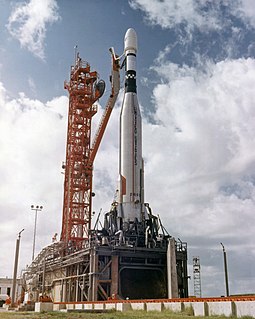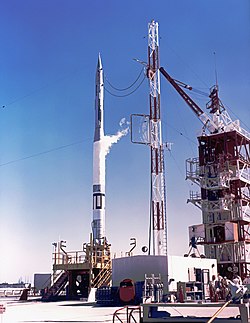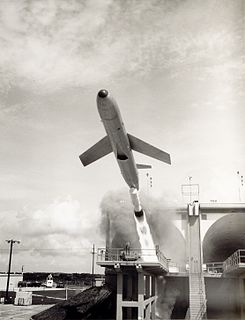
Cape Canaveral Air Force Station (CCAFS) is an installation of the United States Space Force's 45th Space Wing.

Launch Complex 39 (LC-39) is a rocket launch site at the John F. Kennedy Space Center on Merritt Island in Florida, United States. The site and its collection of facilities were originally built for the Apollo program and later modified for the Space Shuttle program.

The Fairchild SM-73 was a sub-sonic, jet-powered, ground-launched decoy cruise missile.

Cape CanaveralAir Force Station Launch Complex 34 (LC-34) is a launch site on Cape Canaveral, Florida. LC-34 and its companion LC-37 to the north were used by NASA from 1961 through 1968 to launch Saturn I and IB rockets as part of the Apollo program. It was the site of the Apollo 1 fire, which claimed the lives of astronauts Gus Grissom, Ed White, and Roger Chaffee on January 27, 1967.

Cape Canaveral Air Force Station Space Launch Complex 17 (SLC-17), previously designated Launch Complex 17 (LC-17), was a launch site at Cape Canaveral Air Force Station, Florida used for Thor and Delta rocket launches between 1958 and 2011.

Cape Canaveral Air Force Station Space Launch Complex 41 (SLC-41), previously Launch Complex 41 (LC-41), is an active launch site at Cape Canaveral Air Force Station.· As of 2020, the site is used by United Launch Alliance (ULA) for Atlas V launches. Previously, it had been used by the USAF for Titan III and Titan IV launches.

Launch Complex 14 (LC-14) is a launch site at Cape Canaveral Air Force Station in Florida. LC-14 was used for various manned and unmanned Atlas launches, including the Friendship 7 flight aboard which John Glenn became the first American to orbit the Earth.

Launch Complex 5 (LC-5) was a launch site at Cape Canaveral Air Force Station, Florida used for various Redstone and Jupiter launches.

Gagarin's Start, also known as Baikonur Site 1 or Site 1/5 is a launch site at Baikonur Cosmodrome in Kazakhstan, used for the Soviet space program and now managed by Roscosmos.
Launch Complex 10 (LC-10) at Cape Canaveral Air Force Station, Florida was a launch pad used by SM-64 Navaho missiles, and later Jason sounding rockets and the Alpha Draco research missile. It was located north of Launch Complex 17, where Launch Complexes 31 and 32 are now located. The pad consisted of a small concrete launch structure with an elevated launch pedestal and built-in flame trench, centered on a small oval-shaped concrete pad.

Launch Complex 11 (LC-11) at Cape Canaveral Air Force Station, Florida, is a launch complex used by Atlas missiles between 1958 and 1964. It is the southernmost of the launch pads known as Missile Row. When it was built, it, along with complexes 12, 13 and 14, featured a more robust design than many contemporary pads, due to the greater power of the Atlas compared to other rockets of the time. It was larger, and featured a concrete launch pedestal that was 6 metres (20 ft) tall and a reinforced blockhouse. The rockets were delivered to the launch pad by a ramp on the southwest side of the launch pedestal.

Launch Complex 12 (LC-12) at Cape Canaveral Air Force Station, Florida was a launch pad used by Atlas rockets and missiles between 1958 and 1967. It was the second-most southern of the pads known as Missile Row, between LC-11 to the south and LC-13 to the north. Along with Complexes 11, 13 and 14, 12 featured a more robust design than many contemporary pads, due to the greater power of the Atlas compared to other rockets of the time. It was larger, and featured a concrete launch pedestal that was 6 metres (20 ft) tall and a reinforced blockhouse. The rockets were delivered to the launch pad by means of a ramp on the southwest side of the launch pedestal.

Launch Complex 13 (LC-13) was a launch complex at Cape Canaveral Air Force Station, the third-most southerly of the original launch complexes known as Missile Row, lying between LC-12 and LC-14. The LC-13 site is currently leased by SpaceX and has been renovated for use as Landing Zone 1 and Landing Zone 2, their east coast landing location for returning Falcon 9 and Falcon Heavy launch vehicle booster stages.
Site 41, also known as Lesobaza and SK-1, was a launch complex at the Plesetsk Cosmodrome in Russia. It consisted of a single pad, Site 41/1, and was used by R-7 derived rockets between 1959 and 1989.

Launch Complex 16 (LC-16) at Cape Canaveral Air Force Station, Florida is a launch complex built for use by LGM-25 Titan missiles, and later used for NASA operations before being transferred back to the US military and used for tests of MGM-31 Pershing missiles. Six Titan I missiles were launched from the complex between December 1959 and May 1960. These were followed by seven Titan II missiles, starting with the type's maiden flight on March 16, 1962. The last Titan II launch from LC-16 was conducted on May 29, 1963.

Launch Complex 18 (LC-18) is a launch complex at the Cape Canaveral Air Force Station, Florida that was active during the late 1950s and early 1960s. It was used by Viking, Vanguard, Thor and Scout rockets. The complex consists of two launch pads, LC-18A, which was originally built by the US Navy for the Vanguard rocket, and LC-18B, which was originally by the US Air Force used for tests of the PGM-17 Thor missile.

Launch Complex 21 (LC-21) at Cape Canaveral Air Force Station, Florida is a launch complex that was used for horizontal launches of cruise missiles between 1958 and 1963. It initially consisted of a single launch rail, from which XSM-73 Bull Goose missiles were tested. Between 1959 and 1960, the complex was rebuilt for the MGM-13 Mace, with a second rail added, and a large concrete structure erected around the launch rails, earning the pad the nickname of "the hardsite".
Launch Complex 25 (LC-25) was a four-pad launch site at Cape Canaveral Air Force Station, Florida built for test flights of the US Navy's submarine-launched ballistic missiles Polaris, Poseidon and Trident from 1958–1979.

The 6555th Aerospace Test Group is an inactive United States Air Force unit. It was last assigned to the Eastern Space and Missile Center and stationed at Patrick AFB, Florida. It was inactivated on 1 October 1990.
Launch Complex 29 (LC-29) was a one-pad launch site at Cape Canaveral Air Force Station, Florida built for test flights of the US Navy's submarine-launched Polaris ballistic missiles from 1958–1980. It also launched Chevaline missiles, which were British Polaris A-3 missiles.















